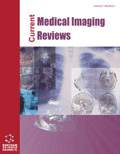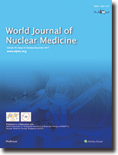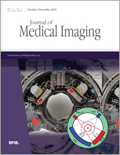
Molecular Imaging
Scope & Guideline
Bridging Disciplines through Cutting-Edge Imaging Techniques.
Introduction
Aims and Scopes
- Molecular Imaging Techniques:
Focus on various imaging modalities including PET, SPECT, MRI, and optical imaging, emphasizing their applications in visualizing biological processes at the molecular and cellular levels. - Clinical Applications:
Exploration of molecular imaging's role in clinical settings, particularly in oncology, neurology, and infectious diseases, to improve diagnosis, treatment planning, and monitoring. - Radiotracer Development:
Development and evaluation of new radiotracers and imaging agents, including their synthesis, characterization, and application in preclinical and clinical studies. - Multimodal Imaging Approaches:
Investigation into the combination of different imaging modalities to enhance diagnostic accuracy and provide comprehensive insights into diseases. - Innovative Imaging Algorithms:
Research into new imaging reconstruction algorithms and computational methods that improve image quality, reduce acquisition times, and enhance data analysis.
Trending and Emerging
- Immuno-PET Imaging:
A growing focus on immuno-PET imaging techniques, particularly in the context of cancer immunotherapy, to visualize immune responses and monitor treatment efficacy. - Metabolic Imaging:
Increased interest in imaging metabolic processes, such as glucose and glutamine metabolism, to understand tumor biology and develop targeted therapies. - Artificial Intelligence in Imaging:
The integration of artificial intelligence and machine learning techniques for image analysis and reconstruction, enhancing the precision and efficiency of imaging studies. - Theranostics:
Emerging research on theranostic applications, which combine therapeutic and diagnostic capabilities, allowing for personalized treatment strategies based on imaging findings. - Stem Cell Imaging:
An uptick in studies focusing on the imaging of stem cells, particularly in regenerative medicine and cancer therapy, to track cell fate and therapeutic outcomes.
Declining or Waning
- Traditional Imaging Techniques:
There is a noticeable decrease in publications focused solely on traditional imaging techniques without molecular applications, suggesting a shift towards more advanced, molecularly-targeted approaches. - Invasive Imaging Procedures:
Fewer studies are being published on invasive imaging techniques, as the field increasingly prioritizes noninvasive methods that align with patient safety and comfort. - Basic Imaging Physics:
Research centered on the fundamental physics of imaging modalities has seen a decline, possibly due to the growing emphasis on clinical applications and translational research. - Single-Modal Imaging Studies:
There is a reduction in studies that focus exclusively on a single imaging modality, as the trend moves towards integrating multiple modalities for a more comprehensive understanding of disease. - Animal Models in Basic Research:
The use of animal models for basic imaging research appears to be waning, reflecting a potential shift towards more clinically relevant studies that directly inform human health outcomes.
Similar Journals

Current Medical Imaging
Bridging Technology and Patient Care in ImagingCurrent Medical Imaging is a reputable journal published by Bentham Science Publishers, specializing in the dynamic field of medical imaging, with a strong emphasis on both clinical applications and technological advancements. Established in 2007, the journal has made significant contributions to the fields of Internal Medicine and Radiology, consistently ranking in the Q3 quartile for these categories as of 2023. The journal's ISSN 1573-4056 and E-ISSN 1875-6603 ensure wide accessibility for scholarly communication, although it operates under a traditional access model. With its continuous publication from 2011 to 2024, Current Medical Imaging aims to bridge the gap between advanced imaging techniques and their practical application in patient care, making it indispensable for researchers, healthcare professionals, and students eager to stay at the forefront of innovations in imaging technology and clinical practice.

EUROPEAN JOURNAL OF NUCLEAR MEDICINE AND MOLECULAR IMAGING
Illuminating the Path of Molecular Imaging DiscoveriesThe European Journal of Nuclear Medicine and Molecular Imaging is a prestigious, peer-reviewed journal published by Springer, dedicated to advancing the field of nuclear medicine and molecular imaging. With an impressive impact factor and ranked in the Q1 category for both Medicine and Radiology, Nuclear Medicine and Imaging, this journal is a pivotal platform for researchers and practitioners to disseminate significant findings from 1996 to the present, reflecting the evolution of the field. The journal boasts a notable Scopus rank, standing at #8 out of 333 in its category, placing it in the top 3% of published works, which highlights its critical importance in shaping contemporary practices and research innovations. Although it does not offer an open-access model, the journal provides various access options to ensure that important research is accessible to professionals, students, and academics alike. Through rigorous peer review and a commitment to high-quality publication, the European Journal of Nuclear Medicine and Molecular Imaging plays an essential role in the advancement of nuclear medicine, contributing to better diagnostic and therapeutic outcomes globally.

ANNALS OF NUCLEAR MEDICINE
Championing Progress in Radiology and Nuclear MedicineANNALS OF NUCLEAR MEDICINE is a prominent academic journal dedicated to the field of nuclear medicine, published by Springer. With a rich publication history dating back to 1987 and continuing through 2024, this journal serves as a vital resource for researchers and practitioners interested in the latest developments in nuclear imaging, radiopharmaceuticals, and therapeutic applications. Ranked in the second quartile (Q2) for both Medicine (miscellaneous) and Radiology, Nuclear Medicine, and Imaging categories in 2023, it maintains a strong position in the academic community, with an impressive Scopus rank of #104 out of 333 in its field, placing it in the 68th percentile. The journal is not open access but offers a range of access options through institutional or individual subscriptions, ensuring that critical research findings reach a wide audience. By fostering high-quality, peer-reviewed articles, ANNALS OF NUCLEAR MEDICINE plays a crucial role in advancing the understanding and practical application of nuclear medicine techniques, making it an essential journal for professionals and students aiming to stay at the forefront of this evolving discipline.

MOLECULAR IMAGING AND BIOLOGY
Pioneering Insights in Oncology and RadiologyWelcome to MOLECULAR IMAGING AND BIOLOGY, an esteemed journal published by SPRINGER that delves into the rapidly advancing fields of molecular imaging and its applications in biology, with a strong emphasis on cancer research, oncology, and radiology. With ISSN 1536-1632 and E-ISSN 1860-2002, this journal has established itself as a prominent platform for disseminating insightful research and innovative methodologies since its inception in 2002. As of 2023, it holds commendable rankings in notable categories—Q3 in Cancer Research, Q2 in Oncology, and Q2 in Radiology, Nuclear Medicine, and Imaging—illustrating its impact and relevance in these disciplines. Furthermore, with impressive Scopus rankings placing it in the top quartile of journals within its categories, it serves as an essential resource for researchers, professionals, and students seeking to stay informed about the latest developments in molecular imaging technologies and biological applications. While currently not an Open Access journal, the rigorous peer-review process ensures high-quality and impactful contributions to the field, making it a valuable addition to any academic library.

World Journal of Nuclear Medicine
Elevating Standards in Nuclear Medicine ResearchWorld Journal of Nuclear Medicine, published by THIEME MEDICAL PUBL INC, is a premier peer-reviewed journal dedicated to advancing the field of nuclear medicine. With an Open Access model established since 2011, this journal ensures that high-quality research is accessible to a wide audience, fostering knowledge sharing and collaboration among researchers, clinicians, and students alike. The journal aims to publish innovative studies, reviews, and clinical trials that contribute significantly to both the theoretical and practical aspects of nuclear medicine, enhancing diagnostic and therapeutic techniques within this critical area of healthcare. As the journal continues to grow in visibility and impact, it remains an essential resource for those seeking to stay at the forefront of advancements in nuclear medicine.

Journal of Medical Imaging
Unveiling the Potential of Medical Imaging ResearchThe Journal of Medical Imaging, published by SPIE-SOC PHOTO-OPTICAL INSTRUMENTATION ENGINEERS, is an esteemed publication in the field of medical imaging, playing a pivotal role in advancing the discipline since its inception in 2014. With an ISSN of 2329-4302 and an E-ISSN of 2329-4310, this journal has garnered significant recognition, evidenced by its Q2 ranking in 2023 within the critical category of Radiology, Nuclear Medicine, and Imaging. The journal is dedicated to presenting cutting-edge research and innovations that enhance diagnostic imaging techniques and methodologies, appealing to a diverse audience of researchers, professionals, and students alike. Offering valuable insights into the interplay of optics and imaging technologies, it serves as a crucial resource for fostering knowledge and collaboration in the medical community. Notably, it holds a competitive rank of #136 out of 333 in its Scopus category, placing it in the 59th percentile—a testament to its influence and relevance in ongoing medical research. Therefore, the Journal of Medical Imaging stands out as an essential platform for disseminating transformative findings and innovations in healthcare imaging.

Egyptian Journal of Radiology and Nuclear Medicine
Empowering Knowledge in Radiology and Nuclear MedicineThe Egyptian Journal of Radiology and Nuclear Medicine, published by Springer, is a premier open access journal that has provided valuable insights and advancements in the fields of radiology and nuclear medicine since its initiation in 2010. With an E-ISSN of 2090-4762, this journal is dedicated to bridging the gap between research and clinical practice, allowing for the dissemination of high-quality research to a global audience. Situated in Germany, it enjoys a robust reputation in the academic community, evidenced by its categorization in the Q3 quartile for 2023, as well as its Scopus ranking, where it holds a position of #225 out of 333 in the domain of Radiology, Nuclear Medicine and Imaging, placing it in the 32nd percentile. The journal's open access model ensures that researchers, professionals, and students can freely access innovative studies, reviews, and case reports that discuss the latest methodologies, technological advancements, and clinical outcomes in radiology and nuclear medicine. As it looks toward its converged years spanning from 2010 to 2024, the Egyptian Journal of Radiology and Nuclear Medicine continues to be an essential resource for advancing knowledge and fostering ongoing collaboration in these critical fields.

RADIOLOGIC CLINICS OF NORTH AMERICA
Illuminating the Path of Radiologic Excellence.Radiologic Clinics of North America, published by W B Saunders Co-Elsevier Inc, stands as a pivotal resource in the field of medical imaging and radiology. With a solid history dating back to 1963 and converging years extending to 2024, this journal has established itself as a reputable platform for original research, comprehensive reviews, and insightful discussions that advance the knowledge and practice of radiology, nuclear medicine, and imaging. Holding a Q2 classification in both the miscellaneous medicine and radiology categories and positioned within the 56th percentile among its peers, its contributions are vital for both academic research and clinical applications. Although it does not offer open access, the journal remains accessible through institutional subscriptions and is a must-read for researchers, healthcare professionals, and students keen on the latest developments in radiological practices. With a dedicated editorial board and a commitment to the highest academic standards, Radiologic Clinics of North America continues to shape the future of the medical imaging field.

Tomography
Pioneering advancements in tomography and diagnostics.Tomography is an esteemed peer-reviewed journal published by MDPI, focusing on a broad spectrum of topics related to medical imaging and diagnostics. Launched in 2015, this Open Access journal serves as a vital platform for researchers, professionals, and students in the fields of medicine, radiology, nuclear medicine, and imaging. With an impressive impact factor reflecting its relevance, the journal has achieved a quartile ranking of Q2 in both Medicine (Miscellaneous) and Radiology, Nuclear Medicine, and Imaging as of 2023. Renowned for disseminating high-quality research, Tomography welcomes original research articles, reviews, and technical notes, fostering innovation and collaboration within the scientific community. Housed in Basel, Switzerland, the journal aims to bridge the gap between fundamental research and clinical application, appealing to a diverse readership eager to advance the field of medical imaging.

Medecine Nucleaire-Imagerie Fonctionnelle et Metabolique
Advancing the Frontiers of Nuclear Medicine.Medicine Nucleaire-Imagerie Fonctionnelle et Metabolique is a prominent journal published by Elsevier France-Editions Scientifiques Medicales Elsevier, dedicated to the specialized fields of nuclear medicine and functional imaging. With an ISSN of 0928-1258 and an E-ISSN of 1878-6820, this esteemed publication has been a crucial platform for the dissemination of research and developments in the discipline since its inception in 1993. Covering a wide array of topics within biophysics, radiological and ultrasound technology, and radiology, the journal currently holds a Q4 category ranking in these fields, reflecting its significance within the academic community. Although there are currently no open access options available for readers, the journal caters to a niche audience of researchers, professionals, and students who seek to enhance their understanding of metabolic imaging and its applications. The 2023 Scopus ranks indicate its position as an emerging source of knowledge in a competitive landscape, making it an important resource for the latest studies and innovations in nuclear medicine.